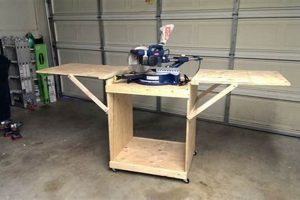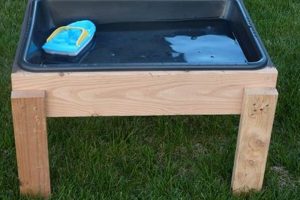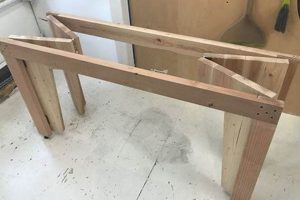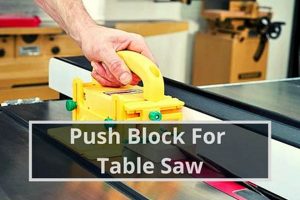Constructions involving homemade cutting implements for wood and similar materials, often referred to with the acronym “DIY,” represent a practical, cost-effective approach to achieving precision cuts in a workshop setting. These fabricated devices emulate the function of commercially manufactured equipment, enabling users to perform ripping, crosscutting, and other shaping tasks. Examples range from simple adaptations of circular saws mounted to tables to more complex builds incorporating fences, miter gauges, and dust collection systems.
The principal advantage of such projects lies in the potential for significant cost savings, especially for individuals with limited budgets or those seeking to customize equipment to their specific needs. Furthermore, the construction process itself fosters a deeper understanding of woodworking machinery operation and maintenance. Historically, resourceful artisans have adapted available tools to optimize efficiency, leading to continuous innovation and the development of increasingly sophisticated designs.
The following sections will explore the fundamental elements involved in constructing a safe and functional homemade cutting device. Detailed considerations concerning design choices, material selection, safety protocols, and performance optimization are addressed. Specific attention is given to achieving accurate cuts and ensuring user protection.
Optimizing Homemade Cutting Implements
Achieving optimal performance and safety when utilizing a fabricated cutting device requires meticulous attention to detail and adherence to best practices. The following guidelines aim to enhance the functionality and longevity of such equipment.
Tip 1: Prioritize Blade Selection. The choice of blade dictates the quality of the cut and the material that can be processed. Carbide-tipped blades provide increased durability and are suitable for hardwoods and abrasive materials. Ensure compatibility with the arbor size and maximum RPM rating of the saw motor.
Tip 2: Implement a Robust Fence System. An accurate and stable fence is crucial for achieving consistent rip cuts. Construct the fence from rigid materials, such as hardwood or metal, and ensure it is securely fastened to the table. Employ a micro-adjuster mechanism for fine-tuning fence alignment.
Tip 3: Integrate a Miter Gauge. For precise crosscuts, a miter gauge is essential. Consider fabricating a miter gauge with adjustable stops to enable repeatable cuts at specific angles. Ensure the miter gauge slot is parallel to the blade.
Tip 4: Incorporate Effective Dust Collection. Sawdust poses both a health hazard and a fire risk. Install a dust collection system that connects to the saw blade housing and any other dust-generating points. A dedicated dust collector or shop vacuum is recommended.
Tip 5: Adhere to Strict Safety Protocols. Always wear appropriate personal protective equipment, including safety glasses, hearing protection, and a dust mask. Never operate the saw without guards in place and always use push sticks or feather boards to keep hands away from the blade. Disconnect power before making any adjustments or repairs.
Tip 6: Ensure Table Flatness and Rigidity. The supporting surface should be flat and stable to prevent vibration and ensure accurate cuts. Reinforce the table structure as needed to minimize flexing. Regularly check the flatness of the table using a straightedge.
Tip 7: Calibrate and Maintain Regularly. Periodically check blade alignment, fence squareness, and miter gauge accuracy. Lubricate moving parts and inspect wiring for damage. A well-maintained tool contributes to both safety and performance.
By implementing these tips, the operator can enhance the capabilities of a homemade cutting device, achieving professional-quality results while minimizing the risk of injury. Diligence and attention to detail are paramount.
The concluding section will address common challenges encountered during fabrication and offer potential solutions, furthering the understanding of this practical approach to woodworking.
1. Accurate Blade Alignment
In the realm of fabricated wood-cutting devices, precise blade alignment is paramount to functionality and safety. Deviations from perfect alignment compromise cut quality, increase the risk of kickback, and reduce the lifespan of the blade. Proper alignment ensures the blade operates within its design parameters, minimizing stress and maximizing cutting efficiency.
- Minimizing Kickback Potential
A misaligned blade can bind within the workpiece, leading to sudden and forceful ejection of the material a phenomenon known as kickback. Accurate blade alignment ensures the blade tracks straight, reducing the likelihood of binding and minimizing this hazardous risk. Proper fence adjustment, in conjunction with blade alignment, is crucial in mitigating kickback.
- Enhancing Cut Quality and Precision
Precise cuts are impossible to achieve with a misaligned blade. Misalignment results in uneven cuts, increased tear-out, and difficulty maintaining consistent dimensions. Adjusting blade to the table surface and miter slot will produce consistently square cuts. Achieving tight-fitting joints and professional-looking results hinges on accurate alignment.
- Extending Blade Lifespan
Forcing a misaligned blade through wood places undue stress on the blade itself, leading to premature wear and potential damage. Overheating, warping, and tooth damage are common consequences. By ensuring proper alignment, the blade operates within its optimal parameters, significantly extending its useful life and reducing replacement costs.
- Reducing Motor Strain
A misaligned blade requires the motor to work harder to achieve a cut, placing excessive strain on the motor’s components. This increased strain can lead to overheating, reduced motor lifespan, and potential failure. Proper alignment reduces the load on the motor, promoting efficient operation and extending the life of the power tool.
Therefore, meticulous attention to blade alignment represents a critical aspect of constructing and maintaining a homemade cutting machine. Prioritizing this element contributes directly to enhanced safety, improved cut quality, increased equipment longevity, and reduced operational costs. It constitutes a foundational principle for successful fabrication and utilization.
2. Stable Fence System
A critical element for fabricated cutting devices involves the integration of a stable fence system. The fence acts as a guide, enabling parallel cuts with a high degree of accuracy. Deviations from parallelism or rigidity compromise cut quality and introduce potential hazards. The following points detail the importance of a robust fence in the context of such constructions.
- Maintaining Parallelism for Rip Cuts
The primary function of a fence is to maintain a consistent distance between the blade and the edge of the material being cut, facilitating accurate rip cuts. Any flex or movement in the fence during the cutting process will result in tapered or inconsistent dimensions. A stable fence ensures the cut remains parallel to the material’s edge, producing boards of uniform width. Examples include using rigid materials like hardwood or metal, and securing the fence with multiple locking points.
- Mitigating Kickback and Binding
An unstable fence can allow the workpiece to drift or bind against the blade, increasing the risk of kickback. A robust, well-aligned fence prevents this lateral movement, reducing the likelihood of the material being forcefully ejected from the apparatus. Factors such as fence height, material, and clamping mechanism are important considerations.
- Enhancing User Safety
A secure fence promotes safer operation by keeping the user’s hands a safe distance from the rotating blade. An unstable or poorly designed fence might require the operator to exert excessive force to maintain control, increasing the risk of accidents. The fence system acts as a physical barrier and a visual guide, helping operators to maintain a safe working posture and avoid contact with the blade.
- Improving Cut Consistency and Repeatability
A stable fence, especially when paired with a reliable locking mechanism and micro-adjustment capabilities, allows for repeatable cuts with a high degree of accuracy. This is crucial for projects requiring multiple pieces of the same dimensions. Features such as adjustable stops or scales enhance the fence’s utility in achieving consistent results.
Therefore, a well-engineered and properly implemented fence is indispensable for safe and accurate operation. The fence directly influences the quality of the finished product and the safety of the user. Design choices should prioritize rigidity, adjustability, and secure clamping to maximize the benefits of the fabricated cutting device.
3. Effective Dust Removal
The operation of a homemade cutting apparatus invariably generates substantial volumes of particulate matter. This dust, composed of wood fibers and potentially hazardous materials from treated lumber, poses significant risks to both the operator and the surrounding environment. Efficient dust removal is therefore not merely an ancillary consideration but an integral component of a safe and functional fabricated cutting device.
Without an effective dust collection system, airborne particles can compromise respiratory health, leading to conditions such as asthma, bronchitis, and allergic reactions. Furthermore, accumulated dust increases the risk of fire and obscures the workpiece, hindering accurate cutting and increasing the potential for accidents. Real-world examples include workshops where inadequate ventilation and dust management have resulted in significant health issues among workers and catastrophic fires caused by accumulated sawdust near ignition sources. Practical applications involve integrating dust ports directly into the saw’s enclosure and connecting them to a dedicated dust collector or shop vacuum. Baffles and strategically placed collection points can further enhance the efficiency of the system.
In summary, the connection between effective dust removal and homemade cutting machines is direct and critical. Implementing a robust dust collection strategy is essential for mitigating health hazards, preventing fire risks, and improving overall operational safety. Prioritizing this aspect of fabrication and usage directly contributes to a healthier and more productive working environment.
4. Robust Table Construction
The stability and integrity of the supporting structure are paramount for any fabricated wood-cutting device. The term “robust table construction” directly relates to the ability of the table to withstand the forces generated during operation, maintain a flat and consistent surface, and provide a secure platform for all attached components. A flimsy or unstable table introduces inaccuracies, increases vibration, and compromises safety. The connection is causal: inadequate construction leads directly to diminished performance and elevated risk.
Consider, for example, a common scenario where a circular saw is mounted to a thin sheet of plywood supported by lightweight framing. The resulting vibrations during cutting can cause the blade to wander, leading to uneven cuts and potential kickback. Moreover, the lack of rigidity can amplify the noise generated by the saw and make it difficult to control the workpiece. In contrast, a table constructed from heavy-gauge steel or reinforced hardwood, with sturdy legs and bracing, provides a stable and vibration-dampening platform. This enhanced stability translates directly into improved cut accuracy, reduced noise levels, and increased user safety. Practical implementations might involve incorporating torsion boxes or using laminated materials to maximize strength and stiffness.
In conclusion, robust table construction is not merely an aesthetic consideration; it is a fundamental requirement for a safe and functional apparatus. The quality of the table directly impacts the accuracy, stability, and longevity of the entire system. Prioritizing material selection, design, and construction techniques to ensure a rigid and stable platform is essential for realizing the full potential of such wood-cutting devices.
5. Comprehensive Safety Measures
The inherent risks associated with power tools are amplified in the context of fabricated wood-cutting devices. Therefore, comprehensive safety measures are not optional enhancements but rather essential prerequisites for the safe operation of any “diy table saws”. The absence of commercially engineered safety features necessitates a heightened awareness and proactive implementation of protective protocols.
- Blade Guard Implementation
A primary safeguard against accidental contact with the rotating blade is a properly designed and installed blade guard. This protective barrier should fully enclose the exposed portion of the blade, allowing for unobstructed workpiece passage while preventing inadvertent contact by the operator. Real-world incidents underscore the importance of this measure, where the absence of a guard has resulted in severe lacerations and amputations. Examples include transparent polycarbonate guards that provide visibility or splitters that prevent material from binding against the back of the blade.
- Anti-Kickback Pawls and Splitters
Kickback, the sudden and forceful ejection of the workpiece towards the operator, constitutes a significant hazard. Anti-kickback pawls, toothed devices that grip the material and prevent reverse movement, and splitters, thin metal pieces that maintain separation behind the blade, are crucial components in mitigating this risk. These mechanisms reduce the likelihood of binding and subsequent kickback events. Implementations may include adjustable pawls that accommodate varying material thicknesses or splitters that align with the blade’s kerf.
- Emergency Stop Mechanisms
In the event of an uncontrolled situation or imminent danger, a readily accessible emergency stop mechanism is critical. This mechanism should immediately halt the saw’s operation, preventing further injury or damage. Strategically placed large button switches or foot-operated kill switches are common examples. Regular testing of the emergency stop functionality is essential to ensure its reliability.
- Personal Protective Equipment (PPE) Usage
Regardless of the engineered safety features incorporated into the system, consistent use of appropriate personal protective equipment is mandatory. This includes, at a minimum, safety glasses to protect against flying debris, hearing protection to mitigate noise exposure, and a dust mask or respirator to prevent inhalation of wood dust. Additional PPE may include push sticks or push blocks to keep hands at a safe distance from the blade and appropriate footwear to prevent slips and falls.
These comprehensive safety measures, when diligently implemented and consistently practiced, significantly reduce the risks associated with fabricated wood-cutting devices. However, it is crucial to recognize that no safety system is infallible, and a responsible operator must always exercise caution and maintain vigilance throughout the cutting process. Continuous evaluation and refinement of safety protocols are essential to address evolving hazards and ensure the ongoing well-being of the user.
Frequently Asked Questions
This section addresses common inquiries and concerns regarding the design, construction, and utilization of fabricated cutting devices. The information provided is intended to enhance understanding and promote safe practices.
Question 1: What are the fundamental differences between a commercially manufactured table saw and a homemade version?
Commercially produced table saws undergo rigorous testing and certification to meet established safety standards. Fabricated devices, lacking such oversight, require meticulous attention to design and construction to ensure operator safety. The availability of advanced features, such as integrated dust collection and electronic controls, also distinguishes commercial models from most homemade counterparts.
Question 2: Is it economically advantageous to construct such a device compared to purchasing a new or used commercial unit?
The economic viability of constructing a fabricated cutting machine is contingent on several factors, including the availability of salvaged materials, the builder’s skill level, and the specific features desired. While initial costs may be lower, long-term expenses associated with maintenance, repairs, and potential safety modifications should be considered. Used commercial units may offer a more cost-effective and reliable alternative.
Question 3: What are the minimum safety features that should be incorporated into a fabricated cutting apparatus?
Essential safety features include a blade guard, anti-kickback pawls, a splitter, and a readily accessible emergency stop mechanism. These components mitigate the risks of blade contact, kickback, and other hazardous events. The implementation of a robust dust collection system is also crucial for respiratory health and fire prevention.
Question 4: How can accurate blade alignment be achieved and maintained in a fabricated device?
Blade alignment requires careful measurement and adjustment using precision instruments. The blade must be parallel to the miter slots and perpendicular to the table surface. Regular inspections and adjustments are necessary to compensate for wear and prevent misalignment, which can compromise cut quality and safety.
Question 5: What type of motor is best suited for powering a fabricated cutting machine?
Induction motors are generally preferred due to their durability, power output, and quiet operation. The motor’s horsepower rating should be appropriate for the intended cutting tasks, with higher horsepower recommended for processing hardwoods or thicker materials. The motor’s RPM rating should also be compatible with the selected saw blade.
Question 6: What are the legal ramifications of constructing and using such a fabricated device, particularly in a commercial setting?
The legal implications of using a fabricated cutting machine vary depending on local regulations and workplace safety standards. In commercial settings, employers are typically responsible for ensuring that all equipment meets or exceeds applicable safety requirements. Fabricated devices may not satisfy these requirements, potentially leading to liability issues in the event of an accident.
These FAQs provide a foundational understanding of critical considerations. Careful evaluation and adherence to best practices are crucial for ensuring safe and effective utilization.
The next article section will explore advanced techniques and modifications for optimizing such devices.
DIY Table Saws
This exploration has elucidated the complexities inherent in the design, construction, and application of homemade cutting devices. The necessity of prioritizing safety protocols, ensuring accurate blade alignment, and implementing robust structural elements has been consistently emphasized. Furthermore, the discussion has highlighted the importance of considering the economic and legal ramifications associated with such endeavors.
Fabricating cutting implements demands a comprehensive understanding of engineering principles and a commitment to meticulous craftsmanship. While the allure of cost savings and customization is undeniable, the potential risks and liabilities necessitate a cautious and informed approach. Users are urged to thoroughly research and carefully evaluate all factors before undertaking such projects, recognizing that responsible implementation is paramount.







